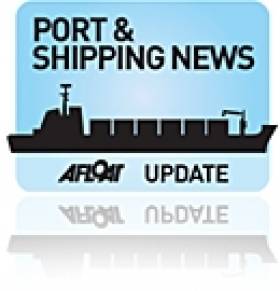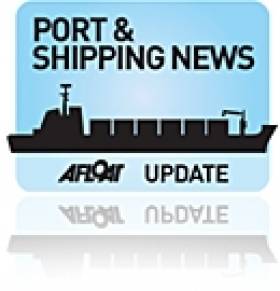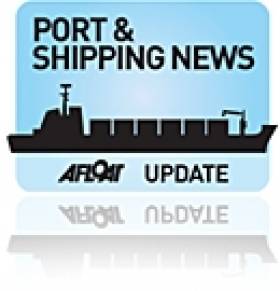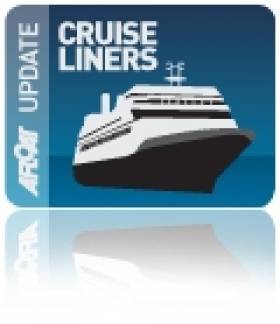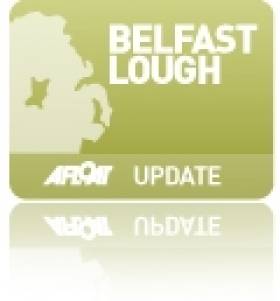Displaying items by tag: Ports and Shipping
Marine Notice No. 42 of 2013
Notice to all Seafarers, Ship Owners, Ship Operators, Seafarer Representative Organisations, Charterers and Recognised Organisations.
Maritime Labour Convention, 2006 – Guidance Notice
The Maritime Labour Convention, 2006 (MLC) entered into force on the 20 th August 2013. The Convention aims to achieve decent working and living conditions for the world's seafarers and to secure fair competition for quality shipowners.
The purpose of this notice is to offer guidance on matters relating to the Convention and to clarify the Department's approach to the items below prior to ratification of the Convention by Ireland and subsequent entry into force.
A. Background
The Maritime Labour Convention, 2006 is a Convention of the International Labour Organization (ILO), which was adopted in 2006 as the "Fourth Pillar" of international maritime law, and embodies all up-to-date standards of existing international maritime labour Conventions and Recommendations, as well as the fundamental principles to be found in other international labour Conventions. The other "pillars" are considered to be the SOLAS, MARPOL and STCW Conventions.
The MLC is comprised of three different but related parts: the Articles, the Regulations, and the Code. The Articles and Regulations set out the core rights and principles and the basic obligations of Members ratifying the Convention. The Code contains the details for the implementation of the Regulations. The Code comprises Part A (mandatory Standards) and Part B (non-mandatory Guidelines). Amendment procedures for the Articles, Regulations, and the Code are established in Article XIV and XV.
The Regulations and the Code are organized into general areas under five Titles:
• Title 1: Minimum requirements for seafarers to work on a ship
• Title 2: Conditions of employment
• Title 3: Accommodation, recreational facilities, food and catering
• Title 4: Health protection, medical care, welfare and social security protection
• Title 5: Compliance and enforcement
Additional Information may be found on the ILO website via the following links:
Dedicated section of ILO website on the Maritime Labour Convention:
http://www.ilo.org/global/standards/maritime-labour-convention/lang--en/index.htm
Text of MLC, 2006: MARITIME LABOUR CONVENTION, 2006
Guidelines for Flag State Inspection:
Guidelines for flag State inspections under the Maritime Labour Convention, 2006
Guidelines for Port State Inspection:
Guidelines for port State control officers carrying out inspections under the Maritime Labour Convention, 2006
MLC 2006 - Frequently asked questions (FAQ) booklet (online edition):
http://www.ilo.org/wcmsp5/groups/public/---ed_norm/---normes/documents/publication/wcms_177371.pdf
A hard copy of the text of the MLC is required to be available to seafarers serving on board Irish vessels to which the Convention is applicable.
B. Guidance from the Department on specific items of the MLC
1. Declaration of Maritime Labour Compliance
A Declaration of Maritime Labour Compliance – Part I , which is required under MLC Regulation 5.1.3, has been issued to all Irish-flagged vessels of 500 Gross Tonnage or more which operate internationally.
Shipowners have completed a Declaration of Maritime Labour Compliance – Part II .
Recognised Organisations have issued, where inspections have been completed, a Statement of compliance with the MLC.
2. Minimum Age
In accordance with MLC Regulation 1.1, the minimum age to be employed or hired or able to work on board an Irish-flagged vessel is 16 years.
Seafarers under the age of 18 shall not be employed or engaged in work where the work is likely to jeopardize their health or safety. When considering whether work is likely to jeopardize health or safety of seafarers under the age of 18, shipowners should take into account the potentially hazardous aspects of operations such as:
Entry into enclosed spaces
Working aloft
Operating deck machinery such as cranes and derricks
Use of paint spray equipment
Use of sand blasting equipment
Use of high pressure washers
Use of pneumatic equipment in general
Operating mooring and windlass machinery.
Night work for seafarers under the age of 18 is prohibited.
However, cadets or trainee deck and engineering officers under the age of 18 who are following a dedicated training programme may work at night, under supervision, at tasks related to their training. Such tasks may include bridge or engine watchkeeping, gangway watch, anchor watch and fire patrols.
Seafarers following a dedicated training programme may not form part of the minimum required manning on the Minimum Safe Manning Document.
3. Medical Certification
As part of the medical examination carried out under the Merchant Shipping (Medical Examinations) Regulations 2005 [S.I. No. 701 of 2005], the hearing of the seafarer is examined by the medical doctor .
Before 1 st January 2013, the Medical Fitness Certificate did not contain a specific statement to the effect that hearing had been examined, as is required by MLC Standard A1.2.6(a). Since that date, revised Medical Fitness Certificates have been issued containing a statement that the hearing of a seafarer has been examined. All Medical Fitness Certificates issued prior to 1 st January 2013 will remain valid until expiry.
4. On-board Medical Care
In accordance with MLC Regulation 4.1, only vessels carrying 100 persons or more and ordinarily engaged on international voyages of more than three days' duration are required to carry a qualified medical doctor. Irish-flagged vessels carrying less than 100 persons are therefore permitted to carry instead either at least one seafarer on board who is in charge of medical care or at least one seafarer who is competent to provide medical first aid, such person to have satisfactorily completed training in either medical care or medical first aid, as appropriate, that meets the requirements of STCW Regulation VI/4/2.
5. Seafarers' Employment Agreements
Traditionally, Irish seafarers use Discharge Books to keep a record of their service. Under MLC Standard A2.1.3, the document containing a record of seafarers' employment shall not contain, inter alia , any statement as to the quality of the seafarers' work.
Therefore, it is suggested that for Irish Discharge Books, two crosses, " ⊠ ", be inserted in lieu of the two columns now present with the headings "For ability" and "For general conduct", and that for persons holding foreign discharge books no remarks be made in these columns.
The requirement that applicants for examination should submit appropriate and full watchkeeping certificates continues to apply.
The Department may issue Discharge Books in the future without columns to comment on conduct and ability but recognises that many seafarers may wish to retain their present Discharge Book.
6. Seafarers following a dedicated training programme for cadet or trainee deck/ engineering officer
The Department recognises that many trainee seafarers, who are following a dedicated training programme, are employed directly by the shipowner, and that these seafarers will be in possession of a seafarer's employment agreement as agreed between the shipowner and the seafarer.
However, it is noted that shipowners may facilitate Nautical Colleges by providing an opportunity for trainee seafarers, who are following a dedicated training programme but who are not employed directly by a shipowner, to gain sea service on the shipowners' vessels. The Department notes and accepts this practice, which promotes seafaring for persons who cannot acquire employment as a trainee, as long as an appropriate agreement is in place.
In the case of cadets/trainees attending the National Maritime College of Ireland (NMCI) who receive such an opportunity to gain sea service, such trainee seafarers may be funded by a fund administered by the Irish Maritime Development Office (IMDO). Details are available on the IMDO website .
7. Further information/contact details
Seafarers, shipowners and seafarers' representative organisations who wish to contact the Department in relation to MLC issues may use the following dedicated e-mail address: [email protected] .
Director General,
Irish Maritime Administration,
Department of Transport, Tourism and Sport,
Leeson Lane, Dublin 2, Ireland.
#Ports&Shipping –The latest IMDO Weekly Shipping Market Review includes the following stories as detailed below.
Irish Economy: Asian export drive - The Asia Trade Forum, an initiative of the Irish Exporters' Association set up to boost two-way trade, is planning a major business mission to two of China's leading business cities, Suzhou and Hangzhou next month. The mission will be similar to last year's visit to India, in which 40 Irish firms took part, said Hugh Kelly, chairman of the Asia Trade Forum. China is forecast to be Ireland's fourth largest export destination by 2030, overtaking countries such as France and Japan.
Panama Canal: Cargo forecast reduction - It is forecast that there will be a fall in cargo volumes of 8 million tonnes in the Panama Canal for 2013, according to Jorge Qiujano, the administrator for the Panama Canal Authority Administrator. This is a decline from the 330 million tonnes forecast to pass through the waterway, as reported by Seatrade Global. The anticipated 2.4% decrease is mainly due the impact of the drought that has affected the US.
Tanker Market: Petrol tanker rates surge -The amount of cargoes booked for tankers to ship European petrol to the US jumped, with rates for these tankers also surging, according to Bloomberg. There was a 14% gain in industry standard Worldscale points for voyages to New York from Rotterdam, the Baltic Exchange reported. Vessels earnings increased by 33%, rising to $19,410 per day.
To read more of each of the above stories and other news from the IMDO Weekly Markets Review for Week 19, click HERE to be viewed or downloaded as a PDF
#ports – A lecture on Green Ports and Harbours by Patrick McCabe will be held this Thursday (March 28th, 6.30pm) at the James Joyce centre, North Great George's Street, Dublin 1.
This lecture explores the changing role of ports and harbours in Ireland and Europe as catalysts for new development in towns and cities. It explores their potential, not just as areas of trade, but their emerging role as knowledge hubs, cultural quarters, recreational landscapes, sustainable energy hubs, and even instigators of agricultural growth.
The lecture draws on the recent work of REDscape in Ireland and the Netherlands.
An ongoing research project by REDscape Landscape & Urbanism, comparing the development of harbours in Asia and Europe led to the creation of a number of spatial initiatives to demonstrate the application of their work, including a vision for the Port of Dublin, "Green Port Dublin" Also discussed are new development strategies, including the public realm plan, led by REDscape for the harbour quarter in Deventer; a self build, bottom up development in an existing industrial area in the Netherlands, recently published in the Dutch yearbook for Landscape Architecture and Urban Design.
All are welcome. Admission is free to ILI members, non-members €5
Tug that Righted “Rambler 100” Barges Ahead
#TOWAGE – The tug Ocean Bank that righted the capsized US entrant Rambler 100 following the Rolex Fastnet Race 2011, arrived in Dublin Bay recently with a barge under tow, writes Jehan Ashmore.
The Rambler 100 had overturned in force-five winds off Fastnet Rock arising from "dramatic and catastrophic" failure of the keel triggered events that ultimately delayed the rescue of the majority of her 21-strong crew, according to the official report by the MCIB into the capsize.
After the rescue of Rambler 100's crew, the yacht remained adrift but eventually was recovered by the Bere Island based tug Ocean Bank to the shelter of Barley Cove, west Cork. From there the 30 tonne bollard pull tractor tug operated by Atlantic Towage & Marine successfully up-righted the yacht.
This week's operation by the Ocean Bank involved towing a completely different type of vessel, the construction barge Skerchi from the south-west coast to a berth alongside Ocean Pier in Dublin Port.
Ports & Shipping Review: Fate of WWI Warship Secured, Ferry Festive Season, HSS Coincides Celebrating 50th, Mersey Ferry Reduction and Proposed Cross-Border Service
#PORTS & SHIPPING REVIEW - Over the last fortnight of 2012, Jehan Ashmore has reported from the shipping scene where a £1m restoration grant is to be spent on the WWI battlecruiser HMS Caroline.
The festive season saw the return of Stena Line HSS fast-craft Dun Laoghaire-Holyhead sailings which coincided with the Swedish owned ferry giant celebrating 50 years in service.
Across Dublin Bay rivals Irish Ferries added capacity to cope with expected demand by transferring Isle of Inishmore from St. Georges Channel service and onto the Dublin-Holyhead route.
Also running seasonal services to from Dublin Port was the Isle of Man Steam Packet Company whose ro-pax Ben-My-Chree provided two weekend round trips either side of the Christmas festivities.
One of the famous 'ferry cross the Mersey' river ferries linking Liverpool to the Wirral Peninsula is to be withdrawn in January 2013 by operator Mersey Ferries due to reduced traffic and heavy losses.
On a more positive note, albeit on other side of the Irish Sea, there are proposals to start a new cross-border car-ferry service across Carlingford Lough between Greenore, Co. Louth and Greencastle Co. Down.
18 Injured as Toxic Gas Leaks from Irish Cargoship
#SHIP TOXIC LEAK - Eighteen people are being treated after toxic gas used to kill rodents escaped from an Irish flagged dry-cargoship docked at Warrenpoint, Co Down.
The cargo on board Arklow Meadow had become wet and unstable. The gas is aluminium phosphide, a pesticide used to kill small mammals such as moles and rodents.
Gardaí have been informed of the potential of the chemical compound to drift into Co Louth. It is understood they are going house-to-house in the Omeath area advising householders to stay indoors and close all windows. For more on this story, RTE.ie reports.
Afloat.ie adds that the 2010 South Korean built vessel is owned by Arklow Shipping Ltd and is one of a five 'M' class series.These vessels each have a total grain capacity of 18,110m3 as previously reported, including the Arklow Manor which last month was dry-docked in Dublin Port.
Ro/Ro Traffic Unchanged as Irish Ports & Shipping Volumes Steady in Third Quarter
#shipping – The volume of port and shipping traffic through the Republic of Ireland remained relatively stable in the third quarter of 2012 according to the figures released today by the Irish Maritime Development Office (IMDO).
The latest analysis of the traffic data indicates that two of the five principal freight segments returned to growth in the third quarter, two declined and one remained unchanged.
FREIGHT SEGMENTS:
Lift-on/lift-off (Lo/lo) trades declined 2%
Container traffic (Lo/lo) has declined by 2% during the third quarter of this year. Exports, as a subset of these figures fell for the second consecutive quarter, declining by 3% as weaker demand conditions prevailed, particularly in the Euro zone area. However, exports to other markets in Asia, South Africa, and both North and Latin America remained relatively firm. Imports declined by 1%, representing the 19th consecutive quarter of declining import volumes. However, the rate of decline in this segment has eased considerably over the course of 2012, possibly indicating the market might be finally bottoming out.
Roll-on/Roll-off (Ro/ro) traffic was unchanged at 0%
Roll-on/roll-off (ro/ro) traffic remained unchanged in the Republic of Ireland for Quarter 3 compared to the same period last year. The majority of ro/ro freight from Ireland is destined for Great Britain which continues to underperform, with leading economic indicators recording weaknesses in the retail and manufacturing sectors. Nonetheless, this is a slight improvement for this shipping market segment having recorded two consecutive quarterly declines earlier this year.
Dry bulk volumes increased by 13%
Dry bulk shipments, which make up the largest volume of traffic throughput at Irish ports, grew by 13% during the third quarter of 2012. Improved domestic demand for agricultural products contributed to the rise while exports of ores and other industrial commodities also performed well.
Tanker/Liquid bulk market increased by 9%
Liquid bulk volumes of tanker based petroleum products increased by 9% in the third quarter. This increase was primarily as a result of large volumes of crude oil being transhipped at Bantry Harbour's oil storage facilities. Excluding Bantry, volumes would have seen a decline of 8% in Quarter 3, which perhaps more accurately reflects domestic demand for petroleum products.
Break bulk volumes down by 10%
Break bulk volumes, which represent the smallest segment of the domestic market, continued to decline into Quarter 3, falling by 10% with no rise in demand for construction related materials such as steel or timber. Demand in this segment remains at historically low levels.
Outlook:
The outlook for the remainder of the year appears to suggest slightly improved conditions in both import and export volumes. This is as a result of a modest pick up in seasonal trade observed during October and early November. Nonetheless, market demand conditions going forward into 2013 remain challenging. The Euro-zone officially entered into its second recession since 2009 during the third quarter this year, while continued uncertainty regarding Greece and some other member states still remains. Globally, much focus has been on the slowdown in the Chinese and other Asian economies. The Irish growth forecast has also been revised downwards for 2013. Sentiment amongst major shipping lines and shipowners remains low. Many shipowners have to deal with a large over supply of shipping capacity in almost all sectors along with weak underlying trade demand, increased operating costs and record low charter markets.
P&O Cruises Adonia… And the First Shall Become the Last
#CRUISE LINERS – The final cruise caller this year to visit Dublin Port tomorrow is P&O Cruises Adonia, which today is at sea, having departed Cobh Cruise Terminal yesterday, as previously reported. Albeit the smallest in the seven-strong P&O Cruise fleet, she was given pride of place as she led the company's 175th anniversary Grand Event held during the summer, writes Jehan Ashmore.
On that momentous day (3rd July) in Southampton, the 30,000 gross registered tonnes Adonia gathered with her considerably larger fleet mates (69,000 – 115,000 grt) and carrying between them 1,800-3,100 passengers each. Unlike her fleet mates however she exclusively caters for adults only and at only 710 passengers, provides for a more intimate cruising experience.
As each cruise ship took it turns to depart after one after the other, they formed a line down Solent waters where the maritime spectacle was an impressive display in seafaring skills and logistics as thousands of passengers had embarked to include Arcadia whose next port of call was Dublin.
The historic day to mark the origins of the famous company formed in 1837 was the theme of a packed out lecture presented by P&O Cruises Managing Director, Carol Marlow during last months' London Ship Show. Marlow, who was a former CEO of Cunard Line, gave an insightful and entertaining talk of the intensive preparations surrounding P&O Cruises day of celebration.
Despite all the planning, one major event that the P&O team could not arrange was for the sun to shine!..instead a rather misty dull overcast day lingered over the Hampshire port. Having said, many hundreds lined the Solent to watch the sail past as each vessel departed on seven cruises. To view a video of the splendid liners and heritage of the famous company click the series of videos HERE.
As for the London Ship Show which was organised by the Ocean Liner Society, this was to be the last time held under its current format where maritime memorabilia stands and lecture programme where provided to all those interested in the world of liners and ferries operating from the UK.
Belfast Lough Deepened for Record Breaking 'Cargo' Ship
#BELFAST LOUGH- The record for the largest single cargo shipment to Belfast Harbour over its 400-year history was broken last Saturday, reports The Belfast Telegraph.
The record was set by the bulk carrier 'Royal Breeze' which was laden with 56,000 tons of coal, having sailed across the Atlantic from Virginia. The vessels mammoth tonnage dwarves the previous largest cargo to arrive at the port of 41,000 tons and follows the deepening of Victoria Channel in Belfast Lough to cater for such large vessels.
The coal is destined for AES UK's Kilroot power station and was unloaded by the harbour's newest crane, the £2.8m, 40m Gottwald - the largest crane in use in any UK or Irish port.
Irish Maritime Law Association: Autumn Lecture
#LECTURE - The Autumn Lecture of the Irish Maritime Law Association will be held on 24 October at the offices of Dillon Eustace Solicitors, Dublin. The lecture will be given by Robin Middleton and will be on the subject of SOSREP, noting the lecture is for members of the association.
The Irish Maritime Law Association was formed in May 1963 for the purpose of allowing Ireland to input into important international shipping conventions. The association takes a very active part in Comite Maritime International (CMI) conferences which are drafted to bring about conformity in private international maritime law.
These include draft conventions on Maritime Liens and Mortgages, Civil Liability for Oil Pollution, Combined Transport, Carriage by Sea of Passengers and Off-shore Mobile Craft, Salvage, and Arrest of Ships. Many of the CMI drafts are later adopted by governments to form a uniform international maritime law.





























